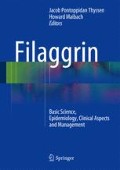Abstract
Treatment of atopic and xerotic skin requires maintenance of skin hydration through daily use of personal care products that most often contain several classes of chemicals not directly needed for the treatment. FLG loss-of-function mutation carriers could be expected to have higher internal exposure to such additive chemicals for two reasons: increased use of personal care products due to xerotic and inflamed skin and/or increased absorption of chemicals through a compromised skin barrier. Phthalates are man-made chemicals used in a wide range of consumer products, including moisturizers and other cosmetics, and are known to be reproductive toxicants in animals. A recent study found that in a group of healthy men, those men with loss-of-function FLG mutations had significantly higher urinary concentrations of phthalate metabolites compared with the “normal” genotype men. Phthalates constitute only one group of chemicals where dermal uptake is an important route of exposure, and it is possible that special attention to transepidermal absorption of many other chemicals, and perhaps topically applied medication in general, may be warranted in FLG mutation carriers.
Access this chapter
Tax calculation will be finalised at checkout
Purchases are for personal use only
References
Dodson RE, Nishioka M, Standley LJ, Perovich LJ, Brody JG, Rudel RA. Endocrine disruptors and asthma-associated chemicals in consumer products. Environ Health Perspect. 2012;120(7):935–43.
Janjua NR, Frederiksen H, Skakkebæk NE, Wulf HC, Andersson AM. Urinary excretion of phthalates and paraben after repeated whole-body topical application in humans. Int J Androl. 2008;31(2):118–30.
Novak N, Baurecht H, Schafer T, Rodriguez E, Wagenpfeil S, Klopp N, et al. Loss-of-function mutations in the filaggrin gene and allergic contact sensitization to nickel. J Invest Dermatol. 2008;128(6):1430–5.
Thyssen JP, Linneberg A, Engkilde K, Menne T, Johansen JD. Contact sensitization to common haptens is associated with atopic dermatitis: new insight. Br J Dermatol. 2012;166(6):1255–61.
Sergeant A, Campbell LE, Hull PR, Porter M, Palmer CN, Smith FJ, et al. Heterozygous null alleles in filaggrin contribute to clinical dry skin in young adults and the elderly. J Invest Dermatol. 2009;129(4):1042–5.
Jakasa I, de Jongh CM, Verberk MM, Bos JD, Kezic S. Percutaneous penetration of sodium lauryl sulphate is increased in uninvolved skin of patients with atopic dermatitis compared with control subjects. Br J Dermatol. 2006;155(1):104–9.
Joensen UN, Jørgensen N, Meldgaard M, Frederiksen H, Andersson AM, Menné T, et al. Associations of filaggrin gene loss-of-function variants with phthalate metabolites and testicular function in young Danish Men. Environ Health Perspect. 2014 Jan 3. [Epub ahead of print].
Wittassek M, Koch HM, Angerer J, Bruning T. Assessing exposure to phthalates – the human biomonitoring approach. Mol Nutr Food Res. 2011;55(1):7–31.
Fisher JS, Macpherson S, Marchetti N, Sharpe RM. Human ‘testicular dysgenesis syndrome’: a possible model using in-utero exposure of the rat to dibutyl phthalate. Hum Reprod. 2003;18(7):1383–94.
Boberg J, Christiansen S, Axelstad M, Kledal TS, Vinggaard AM, Dalgaard M, et al. Reproductive and behavioral effects of diisononyl phthalate (DINP) in perinatally exposed rats. Reprod Toxicol. 2011;31(2):200–9.
Gray Jr LE, Ostby J, Furr J, Price M, Veeramachaneni DN, Parks L. Perinatal exposure to the phthalates DEHP, BBP, and DINP, but not DEP, DMP, or DOTP, alters sexual differentiation of the male rat. Toxicol Sci. 2000;58(2):350–65.
Joensen UN, Frederiksen H, Jensen MB, Lauritsen MP, Olesen IA, Lassen TH, et al. Phthalate excretion pattern and testicular function: a study of 881 healthy Danish men. Environ Health Perspect. 2012;120(10):1397–403.
Carlsen E, Giwercman A, Keiding N, Skakkebæk NE. Evidence for decreasing quality of semen during past 50 years. BMJ. 1992;305(6854):609–13.
Swan SH, Elkin EP, Fenster L. The question of declining sperm density revisited: an analysis of 101 studies published 1934–1996. Environ Health Perspect. 2000;108(10):961–6.
Schmiedel S, Schuz J, Skakkebæk NE, Johansen C. Testicular germ cell cancer incidence in an immigration perspective, Denmark, 1978 to 2003. J Urol. 2010;183(4):1378–82.
Chia VM, Quraishi SM, Devesa SS, Purdue MP, Cook MB, McGlynn KA. International trends in the incidence of testicular cancer, 1973–2002. Cancer Epidemiol Biomarkers Prev. 2010;19(5):1151–9.
Swerdlow AJ, Huttly SR, Smith PG. Testicular cancer and antecedent diseases. Br J Cancer. 1987;55(1):97–103.
Ebata T, Itamura R, Aizawa H, Niimura M. Serum sex hormone levels in adult patients with atopic dermatitis. J Dermatol. 1996;23(9):603–5.
Weidinger S, Schafer T, Malek B, von Schmiedeberg S, Schill WB, Ring J, et al. Association between atopy and cryptorchidism. J Allergy Clin Immunol. 2004;114(1):192–3.
Vestergaard C, Hvid M, Johansen C, Kemp K, Deleuran B, Deleuran M. Inflammation-induced alterations in the skin barrier function: implications in atopic dermatitis. Chem Immunol Allergy. 2012;96:77–80.
Wolff MS, Teitelbaum SL, Pinney SM, Windham G, Liao L, Biro F, et al. Investigation of relationships between urinary biomarkers of phytoestrogens, phthalates, and phenols and pubertal stages in girls. Environ Health Perspect. 2010;118(7):1039–46.
Author information
Authors and Affiliations
Corresponding author
Editor information
Editors and Affiliations
Rights and permissions
Copyright information
© 2014 Springer-Verlag Berlin Heidelberg
About this chapter
Cite this chapter
Joensen, U.N., Thyssen, J.P. (2014). Filaggrin Gene Loss-of-Function Mutations and Exposure to Endocrine Disrupting Environmental Chemicals. In: Thyssen, J., Maibach, H. (eds) Filaggrin. Springer, Berlin, Heidelberg. https://doi.org/10.1007/978-3-642-54379-1_14
Download citation
DOI: https://doi.org/10.1007/978-3-642-54379-1_14
Published:
Publisher Name: Springer, Berlin, Heidelberg
Print ISBN: 978-3-642-54378-4
Online ISBN: 978-3-642-54379-1
eBook Packages: MedicineMedicine (R0)

